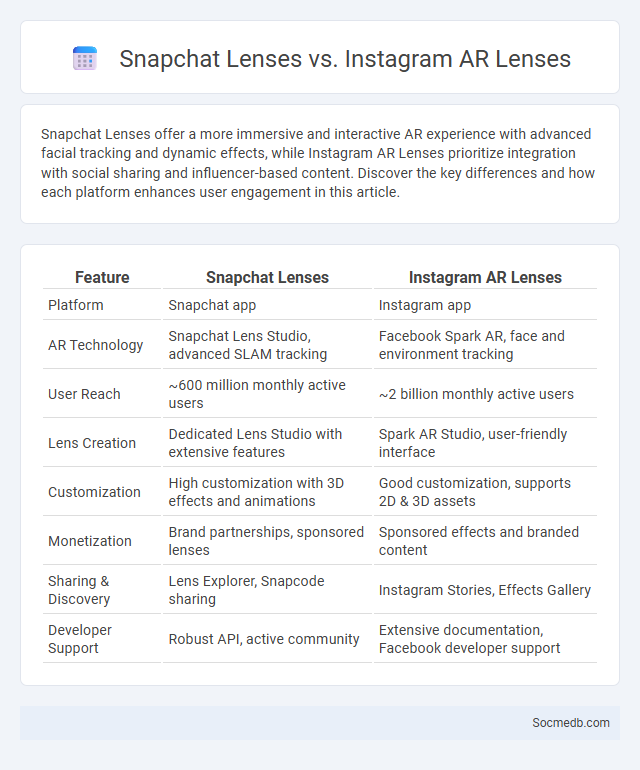
Photo illustration: Snapchat Lenses vs Instagram AR Lenses
Snapchat Lenses offer a more immersive and interactive AR experience with advanced facial tracking and dynamic effects, while Instagram AR Lenses prioritize integration with social sharing and influencer-based content. Discover the key differences and how each platform enhances user engagement in this article.
Table of Comparison
| Feature | Snapchat Lenses | Instagram AR Lenses |
|---|---|---|
| Platform | Snapchat app | Instagram app |
| AR Technology | Snapchat Lens Studio, advanced SLAM tracking | Facebook Spark AR, face and environment tracking |
| User Reach | ~600 million monthly active users | ~2 billion monthly active users |
| Lens Creation | Dedicated Lens Studio with extensive features | Spark AR Studio, user-friendly interface |
| Customization | High customization with 3D effects and animations | Good customization, supports 2D & 3D assets |
| Monetization | Brand partnerships, sponsored lenses | Sponsored effects and branded content |
| Sharing & Discovery | Lens Explorer, Snapcode sharing | Instagram Stories, Effects Gallery |
| Developer Support | Robust API, active community | Extensive documentation, Facebook developer support |
Introduction to AR Lenses: Snapchat vs Instagram
AR lenses transform your social media experience by overlaying digital effects onto real-world images, enhancing user engagement on platforms like Snapchat and Instagram. Snapchat pioneered these interactive filters with advanced facial recognition technology, offering a wide variety of dynamic and playful lens options. Instagram followed by integrating AR effects into Stories and Reels, providing creators with intuitive tools to design custom lenses that resonate with their audience.
What Are AR Lenses?
AR lenses are interactive digital overlays that enhance your social media experience by adding virtual effects to photos and videos in real time. These augmented reality tools use facial recognition and motion tracking to create immersive filters that transform your appearance or surroundings. You can engage your audience with creative AR lenses on platforms like Instagram, Snapchat, and TikTok to boost visual storytelling and increase engagement.
Unique Features of Snapchat Lenses
Snapchat Lenses utilize augmented reality technology to overlay dynamic, interactive animations and effects onto users' faces in real-time, enhancing visual storytelling. These lenses include facial recognition and 3D mapping capabilities, allowing precise tracking of facial movements for personalized experiences. The platform frequently updates with seasonal and trending Lens filters, keeping content fresh and engaging for its primarily young audience.
Distinctive Traits of Instagram AR Lenses
Instagram AR lenses stand out for their advanced facial recognition technology, enabling precise and interactive overlays that respond to real-time movements. These lenses offer unique customization features, allowing creators to design immersive and branded experiences tailored to your audience. By integrating seamless animations and 3D effects, Instagram AR lenses enhance engagement and create memorable visual content.
Technology Behind Snapchat and Instagram Lenses
Snapchat and Instagram lenses leverage augmented reality technology powered by advanced computer vision algorithms and machine learning models to detect facial features and overlay dynamic visual effects in real time. These platforms utilize AR SDKs such as Snap's Lens Studio and Facebook's Spark AR, enabling developers to create interactive filters that respond to user expressions and movements. Your experience is enhanced by these cutting-edge technologies that blend digital content seamlessly with live camera feeds, fostering engaging and immersive social interactions.
User Experience Comparison
Social media platforms like Facebook, Instagram, and Twitter excel in tailored user experiences by utilizing advanced algorithms to personalize content feeds based on user behavior. Instagram offers a visually immersive interface optimized for photo and video sharing, contrasting with Twitter's concise, real-time text updates designed for quick information consumption. Facebook balances diverse multimedia content with robust community engagement features, creating a comprehensive social networking experience that supports varied user interactions.
Creative Tools and Customization Options
Social media platforms offer a wide array of creative tools and customization options that empower users to craft unique and engaging content. Features such as filters, stickers, music integration, and advanced editing tools enable personalized storytelling and brand expression. Customizable templates and interactive elements enhance user engagement, making content more visually appealing and tailored to specific audiences.
Influencer and Brand Engagement
Influencer marketing drives authentic brand engagement by leveraging trusted voices with dedicated followings. Your brand can increase visibility and trust through collaborations that resonate deeply with target audiences. Effective influencer partnerships generate higher conversion rates and foster lasting customer relationships.
Accessibility and Popularity Among Users
Social media platforms prioritize accessibility by offering user-friendly interfaces, voice commands, and screen reader compatibility, making content available to individuals with diverse needs. Their popularity stems from seamless connectivity, real-time updates, and personalized content algorithms that engage millions of users daily. You benefit from these innovations through enhanced communication and easier access to information across various devices.
Future Trends in AR Lenses Platforms
Social media platforms are increasingly integrating advanced AR lenses powered by AI and 5G networks, enabling more immersive and interactive user experiences. Future trends emphasize real-time facial recognition, augmented reality commerce, and customizable virtual try-ons that enhance personalization and engagement. These innovations are set to redefine social interactions and brand marketing strategies across platforms like Snapchat, Instagram, and TikTok.
 socmedb.com
socmedb.com